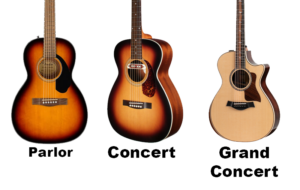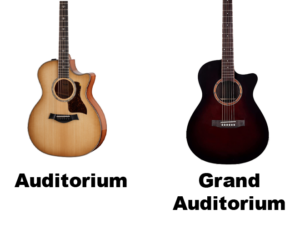Uncategorized
Acoustic Guitar Sizes: Finding Your Perfect Fit
Have you ever wondered how the size of an acoustic guitar affects its sound? From the intimate, focused tones of a parlor guitar to the deep, resonant sound of a jumbo, the size and shape of an acoustic guitar can have a profound impact on its sonic characteristics.”
In this article, we’ll explore acoustic guitar sizes, their variations, and how to choose the perfect size that suits your needs.
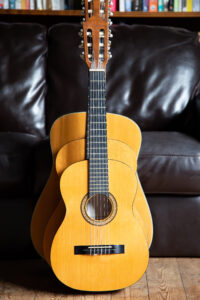 Understanding Acoustic Guitar Sizes: A Musical Puzzle
Understanding Acoustic Guitar Sizes: A Musical Puzzle
Acoustic guitar sizes refer to the dimensions and proportions of the guitar body, which significantly influence the instrument’s tonal characteristics, projection, and playability.
Just like pieces of a musical puzzle, different sizes create distinct voices that cater to various playing styles and preferences.
The Spectrum of Acoustic Guitar Sizes
Acoustic guitars come in several sizes, each with its unique qualities and attributes. Let’s explore some common acoustic guitar sizes and their defining features:
-
-
Parlor Guitar: The parlor guitar is petite and charming, making it an ideal companion for intimate settings.
The name comes from the rooms in which the guitar was typically played in the late 19th century.
Some famous musicians who have been known to use the parlor guitar are, Eric Clapton, Mark Orton, Ed Sheehan, and John Mayer
Its smaller size results in a focused and balanced sound, perfect for fingerpicking and folk music.
-
Concert Guitar: Slightly larger than the parlor guitar, the concert guitar offers enhanced projection and volume. It strikes a balance between portability and sound, making it versatile for various genres.
It is often used in classical music and flamenco music with its full sound.
-
Grand Concert Guitar: With a larger body than the concert guitar, the grand concert guitar boasts a fuller sound and improved tonal complexity.
A popular choice for those who have a smaller stature and require an instrument that’s built to a shorter scale. Great choice for traveling musicians who often play live performances.
It’s suitable for fingerstyle playing and intricate arrangements.
-
Auditorium Guitar: The auditorium guitar, also known as the orchestra model (OM), features a well-rounded sound with a pronounced midrange.
More shallower than the dreadnought and narrower in width than a concert guitar. An Auditorium guitar brings the body closer to the player, making it feel more intimate and comfortable for stage use.
Some famous musicians who play it include Ed Sheeran, John Mayer, and Eric Clapton.
-
Grand Auditorium Guitar: Expanding on the auditorium guitar’s design, the grand auditorium guitar offers a versatile sound profile with enhanced bass response and overall volume.
It is a versatile mid-sized guitar that is a good choice for those who want a single guitar to travel with. The tone is great for strumming and picking. It performs well on stage and in the studio.
It suits a wide range of musical genres.
-
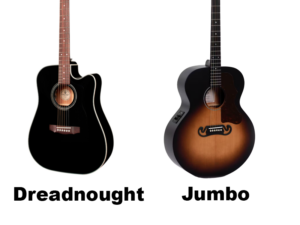 Dreadnought Guitar: The Dreadnought is a true icon, known for its bold and powerful sound. Its large body produces a strong bass response, making it ideal for strumming and vocal accompaniment.
Dreadnought Guitar: The Dreadnought is a true icon, known for its bold and powerful sound. Its large body produces a strong bass response, making it ideal for strumming and vocal accompaniment.This guitar is known for its powerful voice and lower-mid-rich tones that make it a favored choice for country artists. Although it is a popular choice for musicians of all genres.
Some famous musicians who play the dreadnought guitar include Hank Williams Jr, Elvis Presley, Keith Richards, Thom Yorke, and Kurt Cobain.
The original dreadnought guitars were made for the Oliver Ditson Company and featured mahogany backs and sides and spruce tops.
-
Jumbo Guitar: The jumbo guitar lives up to its name with a massive body that delivers robust volume and a deep bass presence.
This is the largest of the guitar family with a deeper body than the popular dreadnought. The body is wider and deeper than traditional acoustic guitars, which gives them a unique appearance.
Jumbo’s are well suited to rhythm guitarists in country and folk rock, and produce a deep rich sound favored by heavy strummers. Some famous musicians who play this guitar are Elvis Presley, George Harrison of the Beatles, Neil Young, Sheryl Crow, and Pete Townshend of The Who.
Choosing the Right Acoustic Guitar Size for You
Selecting the right acoustic guitar size involves considering factors such as playing style, comfort, and tonal preferences. Here are some steps to guide you on your quest:
-
Identify Your Playing Style: Determine whether you lean towards fingerpicking, strumming, or a mix of both. Different sizes excel in different playing styles, so choose one that complements your technique.
-
Consider Body Comfort: Hold and play guitars of various sizes to assess comfort. A guitar that fits well against your body ensures a pleasant playing experience, especially during extended sessions.
-
Evaluate Sound Preferences: Listen to the sound produced by different acoustic guitar sizes. Pay attention to tonal qualities, such as warmth, brightness, and projection, to find the one that resonates with your musical taste.
The Influence of Acoustic Guitar Sizes on Music
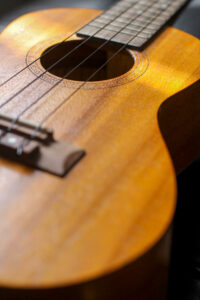 Acoustic guitar sizes and shapes can have a significant impact on the sound of the instrument.
Acoustic guitar sizes and shapes can have a significant impact on the sound of the instrument.The size of the guitar body type also relates to the volume of air within the instrument. Changes to the air capacity of the body will emphasize specific frequencies. A smaller body will have a more focused sound centered on higher frequencies, while a larger body will produce deeper low-end frequencies.
Body dimensions can provide some indication of the tone you might expect, but other factors exert a profound influence, too. Much depends on the tonewoods used to construct the body and the shape, size, and layout of the braces.
Finding Harmony in Acoustic Guitar Sizes
By delving into the nuances of size, sound, and playability, you’ve gained insights that will guide you toward the perfect fit for your musical aspirations.
As you continue your exploration, remember that each acoustic guitar size has its own unique voice and character. Embrace the joy of trying different sizes, celebrate the nuances of their sounds, and let your heart lead you to the one that resonates with your musical soul.
-
Uncategorized
Exploring the Mesmerizing GM7 Guitar Chord: A Gateway to Musical Harmony
Greetings, fellow guitar enthusiasts and curious learners! Are you ready to embark on a melodious adventure that unveils the captivating world of the GM7 guitar chord? Today, we’re diving into the enchanting universe of the GM7 chord – a harmonious treasure that adds depth and allure to your musical toolbox. Whether you’re a budding guitarist eager to expand your chord repertoire or a curious soul seeking to unravel the magic of harmony, this guide will lead you through the harmonious realm of the “GM7 Guitar Chord.” So, grab your guitar, find a comfy spot, and let’s explore the harmonious tapestry of musical expression and creativity!
Revealing the GM7 Chord: A Melodic Key to Unlocking Creativity
Imagine the GM7 chord as a musical key that unlocks a treasure trove of melodic wonders. This chord’s unique tonal quality adds a touch of elegance and richness to your music, making it a versatile choice across various musical genres. Just as an artist selects the perfect brushstroke, the GM7 chord allows you to paint your sonic canvas with notes that evoke emotion and spark creativity.
Mastering the GM7 Chord: Crafting Harmonic Brilliance
Let’s dive into the mechanics of forming the GM7 chord on your guitar. Follow these steps:
1. Finger Placement: Begin by placing your index finger on the 1st fret of the high E string (the thinnest string), marking the root note (G).
2. Middle Finger: Position your middle finger on the 2nd fret of the A string (the fifth thickest string), forming the major third (B).
3. Ring Finger: Place your ring finger on the 3rd fret of the low E string (the thickest string), creating the perfect fifth (D).
4. Pinky Finger: Finally, use your pinky finger to press down on the 3rd fret of the B string (the second thinnest string), adding the major seventh (F#).
5. Strumming: Focus on strumming the low E, A, D, G, and B strings (the thickest through second thinnest strings) while avoiding the high E string (the first string).
6. Sound Check: Strum the strings individually to ensure each note rings out clearly. Adjust finger placement if needed for a resonant sound.
Exploring GM7 Chord Variations: Adding Flair to Your Playing
While the GM7 chord is inherently captivating, you can add variations to enhance its sonic potential. Here are a couple of ways to experiment:
1. Fingerpicking Patterns: Dive into fingerpicking techniques to create intricate patterns that highlight the individual notes of the GM7 chord.
2. Arpeggios: Practice playing the notes of the GM7 chord individually in a sequence, crafting arpeggios that flow like a gentle breeze.
The GM7 Chord in Action: Musical Styles
The GM7 chord’s elegance and versatility make it a favorite choice for songs that demand both sophistication and depth. Here are a few popular songs that feature the GM7 chord:
1. “Fly Me to the Moon” by Frank Sinatra: This timeless classic showcases the GM7 chord’s harmonic richness and melodic allure.
2. “Love Yourself” by Justin Bieber: The GM7 chord adds a touch of elegance to the acoustic pop vibe of this hit song.
Tips for Mastering the GM7 Chord
As you embark on your journey to master the GM7 chord, consider these tips to enhance your playing:
1. Practice Regularly: Dedicate focused practice time to build muscle memory and finger strength for the GM7 chord.
2. Smooth Chord Transitions: Work on transitioning smoothly between the GM7 chord and other chords to improve your overall playing fluency.
3. Experiment with Dynamics: Play the GM7 chord with varying degrees of intensity to explore its full range of tonal expression.
Conclusion: Embrace the Harmony of the GM7 Chord
Congratulations, you’ve embarked on a harmonious journey through the captivating world of the GM7 guitar chord. As you strum, experiment with variations, and play songs, you’ll discover the power of this chord to infuse your music with elegance, depth, and resonance. Keep practicing, keep exploring, and keep embracing the enchanting allure of the GM7 chord. It’s your key to a world of musical expression, where each note resonates with sophistication and allure. So, pick up your guitar, let your fingers dance across the strings, and let the captivating world of the GM7 chord lead you toward a realm of melodies that enchant the senses and elevate the soul, one harmonious note at a time!
Uncategorized
Mastering the Basics: How to Hold a Guitar Pick
Learning to play the guitar is like embarking on a musical adventure, where each strum and pluck paints a unique melody. At the heart of this journey lies a tiny yet crucial tool – the guitar pick. Holding a guitar pick may seem like a simple task, but it’s a foundational skill that sets the stage for your entire playing experience. In this article, we’ll dive into the art of holding a guitar pick, offering step-by-step guidance and practical tips to ensure you start your musical journey on the right note. Get ready to unlock the secrets of a solid guitar pick grip and elevate your playing to new heights!
Introducing the Guitar Pick
Before we delve into the mechanics of holding a guitar pick, let’s take a moment to understand what it is and why it’s important. A guitar pick, also known as a plectrum, is a small, flat piece usually made of plastic, that is used to strike or pluck the strings of the guitar. It’s an essential tool that contributes to the clarity, tone, and precision of your playing.
Step-by-Step Guide: How to Hold a Guitar Pick
Follow these steps to master the art of holding a guitar pick:
1. Choose the Right Pick: Start by selecting a pick that suits your preferences. Picks come in various thicknesses, shapes, and materials. Experiment with different options to find the one that feels comfortable and produces the sound you desire.
2. Position Your Hand: Begin by placing your hand in a relaxed and natural position. Imagine holding a small object, like a coin or a button, between your thumb and index finger.
3. Thumb Placement: Hold the pick with your thumb, pressing it against the side of your index finger’s first joint (closer to the fingertip). The tip of the pick should extend slightly beyond your thumb.
4. Index Finger Placement: Position your index finger on top of the pick, applying gentle pressure to secure it in place. Your index finger should be slightly curved, creating a gentle arc over the pick.
5. Grip Pressure: Maintain a firm but not overly tight grip on the pick. Avoid gripping it too tightly, as this can lead to tension and affect your playing technique.
6. Orientation: Ensure that the pointed end of the pick is facing the strings. This allows for optimal contact and sound projection.
Benefits of Holding a Guitar Pick Correctly
Mastering the proper technique for holding a guitar pick offers several benefits for guitarists:
1. Enhanced Precision: A solid pick grip enables precise control over your picking technique, allowing you to execute intricate patterns and melodies with accuracy.
2. Clear Sound Production: Holding the pick correctly facilitates clean and consistent strikes on the strings, resulting in a clear and defined sound.
3. Reduced Strain: Proper pick grip promotes a relaxed hand position, reducing the risk of strain and discomfort during extended playing sessions.
Practical Tips for Holding a Guitar Pick
Here are some practical tips to help you excel in holding a guitar pick:
1. Relax Your Hand: Avoid tensing your hand while holding the pick. A relaxed hand allows for fluid movement and prevents unnecessary strain.
2. Experiment with Angles: Try angling the pick slightly to achieve different tones and textures. Experiment with different angles to discover the sound that suits your playing style.
3. Practice Picking Exercises: Dedicate time to picking exercises that focus on control and accuracy. Start with slow, deliberate movements, and gradually increase your speed as you build confidence.
Conclusion: Your Musical Canvas Awaits!
Congratulations, you’ve mastered the art of holding a guitar pick! By honing this fundamental skill, you’ve laid the foundation for a successful and enjoyable guitar-playing journey. Whether you’re strumming chords, picking melodies, or embarking on intricate solos, a proper pick grip will empower you to express your musical ideas with clarity and finesse.
As you continue your musical exploration, remember that practice and dedication are key to honing any skill. Embrace the joy of learning, celebrate your progress, and let your passion for music guide you forward. With consistent effort and a love for playing, you’ll find yourself navigating the fretboard with confidence, creating beautiful melodies, and sharing your musical voice with the world.
Holding a guitar pick is just the beginning of your musical odyssey. As you delve deeper into the world of guitar playing, you’ll encounter a myriad of techniques, chords, and musical concepts that will enrich your playing and allow you to create music that resonates with your heart and soul. So, keep strumming, keep learning, and most importantly, keep enjoying the wonderful journey of creating music with your guitar. Happy playing!
Uncategorized
Discovering the Soulful Sound: B Minor 7 Chord on Guitar
As you journey through the enchanting world of guitar playing, you’ll encounter a rich tapestry of chords that add depth and emotion to your musical compositions. Among these, the B minor 7 chord on the guitar stands out as a soulful and evocative choice. In this article, we’ll delve into the captivating realm of the B minor 7 chord, explore its formation, provide practical fingering tips, and uncover its significance in creating melodies that tug at the heartstrings. Get ready to unlock the secrets of the B minor 7 chord and elevate your guitar-playing skills to new heights!
Unveiling the B Minor 7 Chord
The B minor 7 chord, also written as Bm7, is a versatile and expressive chord that can add a touch of sophistication to your music. Comprising four notes – B, D, A, and F# – the B minor 7 chord has a melancholic yet serene quality that makes it a favorite among guitarists seeking to evoke introspection and emotion.
Forming the B Minor 7 Chord
Follow these steps to master the art of playing the B minor 7 chord on the guitar:
1. Position Your Fingers: Begin by placing your index finger on the 2nd fret of the A string (second from the top). Your middle finger will press down on the 2nd fret of the D string (third from the top), and your ring finger will be on the 2nd fret of the G string (fourth from the top). Allow the high E string (thinnest string) to remain open.
2. Strum the Chord: Strum from the A string to the high E string, ensuring that each string produces a clear and resonant sound. Avoid strumming the low E string.
Benefits of the B Minor 7 Chord
Mastering the B minor 7 chord offers several benefits for guitarists:
1. Expressive Emotion: The B minor 7 chord’s somber and contemplative character adds emotional depth to your compositions, allowing you to convey a wide range of feelings through your music.
2. Chord Progressions: Incorporating the Bm7 chord into your chord progressions can create captivating and dynamic musical journeys, enriching your compositions with harmonic complexity.
3. Smooth Transitions: Learning to transition smoothly between the B minor 7 chord and other chords enhances your overall playing technique and enables you to create seamless chord changes.
Practical Tips for Mastering the B Minor 7 Chord
Here are some practical tips to help you excel in playing the B minor 7 chord:
1. Finger Placement: Focus on proper finger placement to ensure that each note within the chord rings out clearly. Use the tips of your fingers to press down on the strings, and avoid any unintentional muting or buzzing.
2. Chord Transitions: Practice switching between the B minor 7 chord and other chords in your repertoire. Start with slow and deliberate changes, gradually increasing your speed as you become more comfortable.
3. Strumming Patterns: Experiment with different strumming patterns to create varied rhythmic textures with the Bm7 chord. Whether you’re using your fingers or a pick, explore patterns that suit the mood and style of your music.
Famous Songs Featuring the B Minor 7 Chord
The B minor 7 chord’s distinct and emotive sound has graced numerous famous songs across genres. Here are a few examples:
1. “Don’t Know Why” by Norah Jones: This soulful ballad features the Bm7 chord, contributing to the song’s introspective and intimate atmosphere.
2. “Blackbird” by The Beatles: The B minor 7 chord plays a vital role in creating the delicate and intricate fingerstyle melody that defines this classic tune.
3. “Fly Me to the Moon” by Frank Sinatra: This timeless jazz standard incorporates the Bm7 chord, adding a touch of elegance to the sophisticated chord progressions.
Conclusion: Your Musical Palette Expands!
Congratulations, you’ve delved into the captivating world of the B minor 7 chord on the guitar! By mastering this expressive chord, you’ve added a powerful tool to your musical palette, enabling you to craft melodies that resonate with emotion and depth. Whether you’re strumming along to your favorite songs, composing your melodies, or experimenting with chord progressions, the B minor 7 chord empowers you to express yourself authentically.
As you continue your guitar-playing journey, remember that practice and dedication are essential to mastering any aspect of playing. Embrace the challenges, celebrate your progress, and let your passion for music guide you forward. With consistent effort and a love for learning, you’ll find yourself weaving captivating melodies, harmonizing with other chords, and expressing your unique musical voice.
The B minor 7 chord is just one step on your musical odyssey. As you delve deeper into the world of guitar playing, you’ll encounter a variety of chords, techniques, and musical concepts that will enrich your playing and allow you to paint your musical canvas with a range of emotions. So, keep strumming, keep learning, and most importantly, keep enjoying the wonderful journey of creating music with your guitar. Happy playing!
-
advanced9 years ago
How to Play “Sleepwalk” on the 3-String Guitar! Guitar TABs Included!
-
beginner8 years ago
3-String or 4-String? How to Decide Which is Right for You!
-
beginner9 months ago
Exploring Different Guitar Types: A Beginner’s Guide
-
Blues Guitar8 years ago
Go-To Tunings for Blues Slide Guitar
-
advanced9 months ago
Fun and Effective Guitar Exercises: Elevate Your Playing with These 5 Simple Techniques
-
Blues Guitar7 years ago
Jack Daniel’s Whiskey Barrel Guitar: How It’s Made and What it Sounds Like
-
Guitars9 months ago
Bass vs Guitar: Exploring the Musical Journey
-
Uncategorized8 years ago
How to Play THE BEATLES’ “Come Together” on the 3-String Guitar

